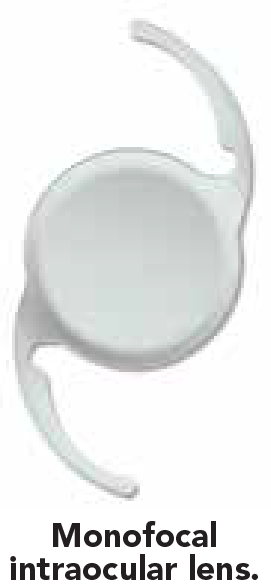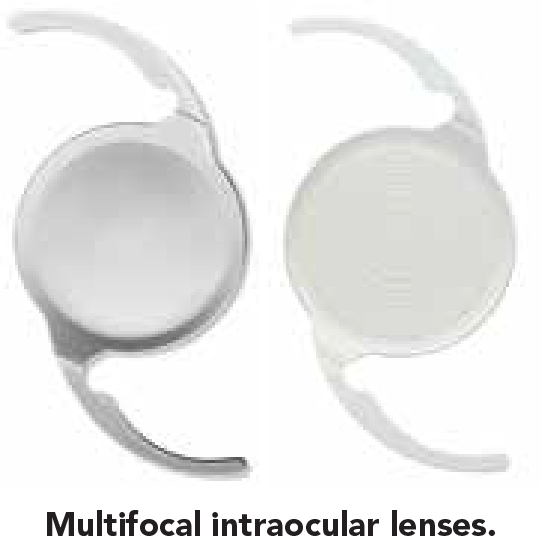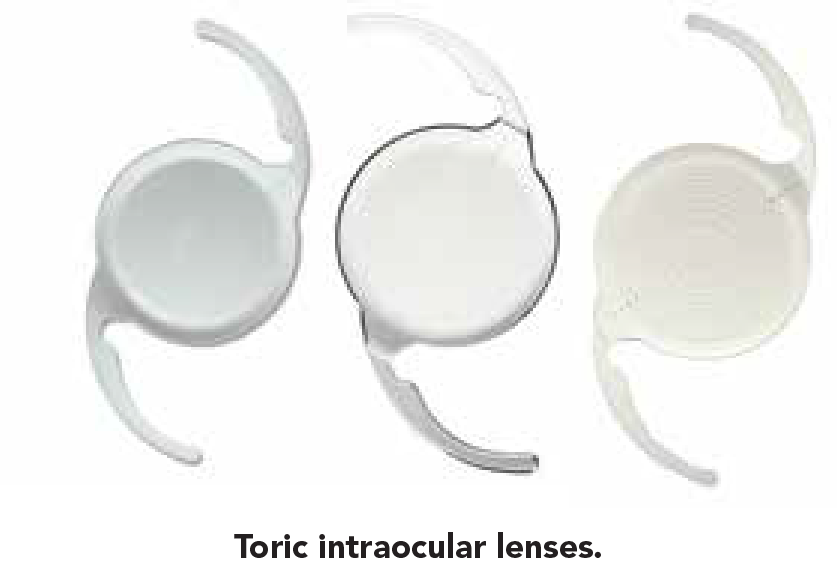Cataract surgery involves removing the natural lens in your eye that has become cloudy and is affecting your vision. An artificial lens implant is placed in the eye in order to restore vision. There are various types of lenses that can be implanted.
Monofocal Lenses

These are the most commonly implanted lenses, which are designed to achieve good vision for a single, specific distance (focal point). It is usually set for distance vision, although it can be set for near or intermediate vision. When set for distance vision, glasses are usually not required. However, reading glasses will be required for near and intermediate vision. Nevertheless, quality of vision is excellent for both distance and near with reading glasses.
Multifocal Lenses

Multifocal lenses provide the opportunity to be less dependent on glasses for distance, near and intermediate vision. These lenses work by projecting light into the eye from two or three focal points. Hence, a person is able to have good vision for both near and far objects.
The artificial lens implant is different from your natural lens. The natural lens is able to focus by changing its shape and its position, to give a wide range of focal points. With ageing, the natural lens loses its ability to focus for near. This is called presbyopia or lăo huā (老花).
The multifocal lens does not change shape but projects both near and far images into the eye at the same time. It is because of this design that one may see glare or haloes with a multifocal lens.
Enhanced Depth of Vision Lenses
These are lenses of a newer design, which project images over a range of distance rather than a single point. It allows the person to achieve good distance and intermediate vision. Glare and haloes are also associated with these lenses.
Comparison of Monofocal and Multifocal/Enhanced Depth of Vision Lenses
- Monofocal lenses usually will require the patient to wear reading glasses for near while
multifocal/enhanced depth of vision lenses would reduce the dependence on reading glasses. - Glare and haloes are common for multifocal/enhanced depth of vision lenses while very rare in monofocal lenses.
- Contrast and quality of vision is excellent for monofocal lenses, and good in multifocal/enhanced depth of vision lenses.
- A good lighting environment is essential for multifocal/enhanced depth of vision lenses, and less so for monofocal lenses.
Are Multifocal or Enhanced Depth of Vision Lenses Suitable for Everyone?
No, although it can be recommended for many people, especially those who are keen to be more spectacle independent.
However, some patients may have conditions which make them unsuitable. These conditions include:
-
Retinal problems (eg. macular degeneration, epiretinal membranes, macular holes, significant diabetic eye disease, retinal dystrophies or vascular occlusions).
-
Optic nerve damage (eg. advanced glaucoma affecting central vision, optic neuropathies).
-
Corneal disorders (eg. irregular astigmatism, scarring, keratoconus or dystrophies).
-
Patients with previous refractive surgery (LASIK, PRK, RK).
Patients who engage in certain activities may also find these lenses unsuitable. These include frequent night driving, working in or performing activities in dim lighting environments. Patients with very high expectations may also find these lenses not suitable for their needs.
Surveys suggest that the vast majority of patients with multifocal lens implants are very satisfied with them. However, a small number of patients do not adapt to the lenses or find that they are bothered by the glare and haloes. These patients may require a second surgery to exchange the lens, which carries some risk.
Your doctor will assess and discuss the advantages and disadvantages with regards to your individual needs and expectations.
Toric Lenses

Astigmatism or săn guāng (散光) can be corrected with a toric lens. Reducing the amount of astigmatism reduces your dependence on glasses. The properties of a toric lens can be incorporated into monofocal, multifocal and enhanced depth of vision lenses. It is also essential to reduce astigmatism for multifocal or enhanced depth of vision lenses to allow them to function properly.
A toric lens needs to be correctly aligned in order to correct for astigmatism. Uncommonly, the lens may sometimes rotate after cataract surgery and its efficacy reduced. In these cases, the lens may need to be rotated to its appropriate position in a second operation. A monofocal toric lens does not cause glare or haloes.
Monovision
Some patients may elect to have one eye set for distance vision and the other eye set for near. This is called monovision and is usually used for monofocal lenses. When the patient uses both eyes to see, they are able achieve both distance and near vision. The eye set for near would be made shortsighted or myopic, usually in the range of -1.25D to -2.5D. Not every patient can adapt to monovision.
